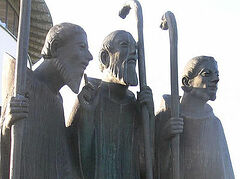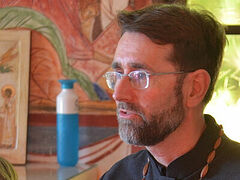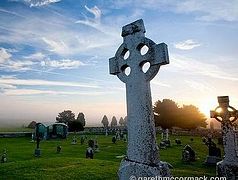The following is the first installment of an overview of the saints of what is now called, Benelux.
 St. Servatius of Tongeren. Photo: wikipredia.net
St. Servatius of Tongeren. Photo: wikipredia.net
The term Low Countries designates a historic region of northwestern Europe comprising the modern nations of Belgium, Luxembourg, and the Netherlands. In contemporary parlance these countries are sometimes collectively referred to as the Benelux, a moniker made up of the first few letters of their respective names. Consisting in the main of coastal lowlands, their geographical proximity and shared histories make their grouping together logical, despite some differences of language and culture. The historic regions of Wallonia, Flanders, and the Brabant, among others, were the historical soil from which these nations grew, producing rich and distinctive cultures.
 Map of the Benelux Countries, with major cities (Image: Wikipedia)
Map of the Benelux Countries, with major cities (Image: Wikipedia)
These essays will attempt to trace in broad strokes the Orthodox history of this unique region of Europe. As with the rest of Western Europe in general, the Christian history of these lands tends regrettably to be viewed almost entirely through post-Schism eyes. Yet, as with the rest of Europe, the Orthodox history of the Low Countries is quite ancient and venerable, having begun (albeit tentatively and on a limited basis) in Roman times, and it stretched right up to the eve of the West’s tragic Schism.
Rather than attempting a historical survey, the focus here will be principally on the lives of this region’s saints, for it is in and through these great luminaries that the Gospel was lived out and embodied in these lands. To truly know any people’s Orthodox history, one needs only to study their saints. And the Low Countries positively teemed with them.
I. Early Figures
St. Martin of Tongeren (†c.350)
St. Servatius of Tongeren (†384)
As Tongeren (aka, Tongres) is the oldest city in Belgium, and in ancient times was the only Roman administrative center in that land, it makes sense that two of the earliest saints of the region should both be associated with this city. In Roman times it was called Tungrorum, and was the capital of the Civitas Tungrorum administrative district. A group of tribes called the Tungri, from which the city and district derived its name, predominated in the area then.
A pair of fourth century saints are associated with this city and region. However, precious little is now known about their lives and activities. One was St. Martin of Tongeren. He was the seventh bishop of Tongeren, a see founded in the early fourth century by St. Maternus (†315). St. Martin, as might logically be expected due to the widespread paganism in Northern Europe at that time, had apparently a strong missionary focus. He evangelized the Hesbaye area, a region of present-day eastern Belgium between the Meuse and Scheldt rivers. He reposed around the year 350 and his feast is June 21.
A good bit more is known about the life of St. Servatius of Tongeren. He was apparently of Armenian origin, and was also apparently quite well travelled—especially for his era. How he came to reside in present-day Belgium is unclear. What is known is that he was a distinguished and determined opponent of Arianism, firmly defending the Orthodox teaching of the divinity of Christ. In this he was closely allied with St. Athanasius the Great of Alexandria (†373), whom he may have met during the latter’s exile in Trier. St. Servatius participated in important Church councils, such as the Council of Rimini (Ariminum). He was also an envoy on a diplomatic mission to Emperor Constantius II. One of the most remarkable stories from St. Servatius’ life comes to us from St. Gregory of Tours (†594), who tells of Servatius’ prophetic vision of an impending Hun invasion of Tongeren. This occurred while St. Servatius, apparently on pilgrimage at the time, was praying during a vigil service at the tomb of St. Peter in Rome. As a result of this vision, in which the Apostle himself appeared to St. Servatius, he was able to arrange the safe transfer of certain holy relics from Tongeren to Maastricht. In that latter city the holy man reposed, apparently peacefully, and was buried in the year 384.
Figures such as Saints Martin and Servatius (and their contemporaries and predecessors) give us a glimpse into the ancient Christian presence in this region of Northern Europe, with its fairly well-established ecclesiastical structure. However, paganism remained entrenched and widespread. The lasting and pervasive Christianization of the Low Countries would be a few centuries coming still, and it is to this era and its great missionary figures that our attention now turns.
To be continued…






